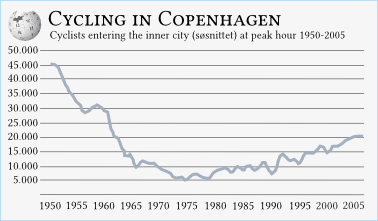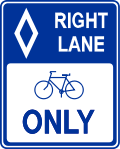Bikeway controversies
Controversies have surrounded bikeways, particularly in North America and the United Kingdom and specifically between those who prefer to focus on education rather than separated cycling infrastructure and those who prefer to create dedicated facilities to make cyclists safer and make it more inviting to a wider public. Other dissenters say safety is better served by using the road space for parking.[1]

Context controversy
Some detractors argue that one must be careful in interpreting the operation of dedicated or segregated bikeways/cycle facilities across different designs and contexts; what works for the Netherlands won't necessarily work elsewhere. Proponents argue that segregated cycle facilities have been implemented and are both popular and safe.
The Netherlands, detractors argue, is a flat country and the compact design of Dutch towns keeps cycling distances short as reflected in the Dutch people's choice of bicycle, i.e. the typical Dutch roadster, which has either no gears or a three-speed hub gear and back pedal brakes. Other countries may have different common urban designs, such as sprawling suburbs, and different cycling cultures where riders may ride bicycles with a wider range of gears and like to travel more quickly, such as those who cycle regularly for sport and exercise, who may choose to ride to incorporate some aerobic exercise into their day. So, while a sidepath system may work for slower cyclists, detractors argue, they might not work for cyclists using faster bicycle types who cannot use such a system safely at their higher normal cycling speeds.[2] However, this is contradicted by members of the Royal Dutch Cycling Union, who state that Dutch competitive cyclists have no problems with training in the Netherlands.[3] The Danish Roads Directorate state that the cycle track system "functions best when cyclists travel at relatively low speeds"[4] but what is meant by 'relatively low speeds' is not made clear. There are instances where cycle tracks / sidepaths can accommodate fast cycling as evidenced in this video of a velomobile on a Dutch cycle track.
As more cycle tracks are built in North American cities, more research is being conducted on the uptake and safety of cycle tracks. North American cities that have recently installed cycle tracks have seen significant growth in cyclists using these roads.[5][6] It is useful, therefore, to use North American examples of cycle tracks/side paths and compare them to similar roads used by cyclists. This will provide better data using cyclists on similar terrain and presumably similar bicycles and experience.

Cycling activists in favour of vehicular cycling have opposed cycle tracks and paths on the principle that they might not be created with the "fast cyclist type" in mind. The UK’s Sustrans guidelines for the National Cycle Network are based on recreational use with a design user who is an unaccompanied twelve-year-old. The Dublin Transportation Office has advertised their cycle facilities as being based on an unaccompanied ten-year-old design user. This raises the issue of what happens if different cyclist types find themselves forced onto such devices either by legal coercion or as a result of motorist aggression. This issue is captured in a 1996 review of the Sustrans approach from the Proceedings of the Institution of Civil Engineers.
The fast cycle commuter must not be driven off the highway onto a route that is designed for a 12-year-old or a novice on a leisure trip, because if that happens, the whole attempt to enlarge the use of the bicycle will have failed[7]
Maintenance controversy

Facilities must be made wide enough for the street sweepers and snow plows typically used in a locale, or the locale will need to ensure that they are regularly swept or plowed by machines that will fit.
Some locales have issues with debris in the cycle paths, such as Milton Keynes, UK, finding that cycle path users are seven times more likely to get punctures than are road cyclists.[8] In Ireland some cyclists have demanded simultaneous commitment to maintenance and sweeping as cycle paths are built.[9]
In areas subject to high leaf-fall in autumn, or high snowfall in winter, any cycle facilities must be subject to regular clearing if they are to remain usable. Danish guidance specifies three different categories of cycle track.[4] Category "A" tracks must be kept clear of snow 24 hours a day, category "B" tracks are swept or cleared daily, and category "C" receive less regular winter maintenance. In 2007 the city of Copenhagen spent DKK 9.9 million (US$1.72 million, €1.33 million) annually on maintaining its cycle track network.[10] German federal law requires local authorities to declassify cycle tracks that do not conform to strict design and maintenance criteria.[11] In the UK, facilities for non-motorized traffic are not normally salted or gritted in icy conditions, potentially making them dangerous or unrideable.
Cycle lanes avoid this problem, as they are part of the road and can be easily accessed by maintenance vehicles operating on that road, incurring no extra cost. They only becomes filled with debris if the road is not maintained or the lane is purposely avoided.
Tracks used at night can be illuminated by conventional means, or by paving with glowing material.[12]
Usage controversy

There are many factors, such as cycle tracks and other cycling infrastructure, which contribute to cycling levels. A number of cities have demonstrated that particular cycle tracks will increase bike traffic on those routes, as shown, for example, in Montreal, New York City and Copenhagen. Bike usage increased by 40% in areas of Montreal where the city invested in bike paths and lanes.[5][6] In Copenhagen bike traffic increased by about 20% because of the construction of cycle tracks.[13] The construction of separated bike lanes on Dunsmuir Street and Viaduct in Vancouver, Canada, saw bike traffic volumes on the street more than double from before the construction.[14] NYC likewise saw cycling rates nearly triple on weekdays and doubled on weekends when the bike path was installed alongside Prospect Park West.[15]
Seville, Spain, is an example of what is possible on a city scale when a large investment is made in cycling infrastructure over a short period of time. In 2006 there were around 6000 bike trips made daily in the city of around 700,000. By 2009 there were about 50,000 daily bike trips. During those three years 8 urban bike paths totaling 70 km were built; the city centre was closed to motorised traffic; school projects were funded to create safe school paths; traffic calming measures were provided in school districts and the bicycle sharing system ‘Sevici’ was launched. The combination of all these factors helped to create a dramatic change in cycling rates.[16]
After a certain trip modal share it may take more than just installing cycle tracks to create large increases in cycle rates. Cycling rates in the Netherlands peaked in the 1960s and dropped dramatically until the mid-1970s. The decline in bicycle use was "not only caused by mass motorization but also by the related, fairly unco-ordinated process of urbanization and by scores of social, spatial and economic developments", such as a decrease in population density and increased travel distances. The bicycle was almost completely left out of the national government's vision. Certain cities, however, such as Amsterdam and Eindhoven, were slowly implementing more bicycle-positive policies: for example, bike-only streets and allowing cyclists to ignore one way streets.[17] Throughout the 70s cycling rates increased, but the investments in bike paths made in the subsequent period had less effect. Between the late 1980s and early 1990s the Netherlands spent 1.5 billion guilders (US$945 million) on cycling infrastructure, yet cycling levels stayed practically the same.[18]
When the flagship Delft Bicycle Route project was evaluated, the Institute for Road Safety Research claimed that the results were "not very positive: bicycle use had not increased, neither had the road safety. A route network of bicycle facilities has, apparently, no added value for bicycle use or road safety".[19] The study by Louisse, C.J. et al. however, did find that "[a]lthough the total number of victims among cyclists did not decline, the percentage of fatalities and severely injured did drop dramatically."[20] A more comprehensive policy change in addition to bicycle routes, on the other hand, helped to raise the cycling rates in Groningen where 75% of all traffic is by bike or foot. Groningen focused on land use policy, city planning and economic policy changes to achieve very high cycling rates.[18]
In the UK, a ten-year study of the effect of cycle facilities in eight towns and cities found no evidence that they had resulted in any diversion from other transport modes.[21] The construction of 320 kilometres (200 mi) of "Strategic cycle network" in Dublin has been accompanied by a 15% fall in commuter cycling and 40% falls in cycling by second and third level students.
In some locales bike traffic increases first and bike paths and lanes are installed in order to catch up to the demand. For instance, bike planning in Davis, California was driven by the prior existence of a "dramatic volume" of cyclists in the 1960s.[22] Research on the German bicycle boom of the 1980s paints a picture of German local authorities struggling to keep up with the growth of cycling rather than this growth being driven by their interventions.[23] In relation to the UK, it has been argued that locally high levels of cycling are more likely to result from factors other than cycle facilities. These include an existing cycling culture and historically high levels of cycle use, compact urban forms, lack of hills and lack of barriers such as high speed intersections.[24]
However, Pucher and Buehler, U.S.-based researchers, have stated that "the provision of separate cycling facilities" appears to be one of the keys to the achieving of high levels of cycling in the Netherlands, Denmark and Germany.[25]
Segregating cyclists controversy
In some cases, cycle paths have been constructed so bicycles could be prohibited from the main roadway.[26][27] There is a debate among cyclists as to whether this is for the benefit of motorists or bicyclists.
In 1996 the UK Cyclists' Touring Club and the Institute of Highways and Transportation jointly produced a set of Cycle-Friendly Infrastructure guidelines that placed segregated cycling facilities at the bottom of the hierarchy of measures designed to promote cycling.[28] Planners at the Directorate Infrastructure Traffic and Transport[29] in Amsterdam place cyclists and motorists together on roads with speed limits at or below 30 km/h (19 mph), and segregate them through bicycle lanes at higher limits. This is in a context where most of the measures prioritised by Cycle-Friendly Infrastructure (HGV restrictions, area-wide traffic calming, speed limit enforcement etc.) are already in place – see Utility cycling for more detail.
- An obstructed cycle lane in New York City.
 Bicycle lane sign in New York City.
Bicycle lane sign in New York City. Share the road sign, New York City.
Share the road sign, New York City. United States bicycle lane sign with diamond (lozenge) symbol.
United States bicycle lane sign with diamond (lozenge) symbol. Bike Allowed Use of Full Lane CVC 21202, San Francisco.
Bike Allowed Use of Full Lane CVC 21202, San Francisco. Bicycles only sign in Ukraine.
Bicycles only sign in Ukraine.
References
- Mulvaney, Nicole (February 18, 2015). "Bike lane or parking? Princeton residents weigh in on Hamilton Avenue options". N. J. News. nj.com. Retrieved 10 July 2015.
- The Bikeway Controversy, J Forester, Transportation Quarterly, Vol 55 No 2. Spring 2001
- Email exchange with Thorvald Veneberg on http://karlmccracken.sweat365.com/ Archived 2013-02-03 at Archive.today
- Collection of Cycle Concepts Archived 2007-09-27 at the Wayback Machine, Danish Roads Directorate, Copenhagen, 2000
- Lusk, A. C.; Furth, P. G.; Morency, P.; Miranda-Moreno, L. F.; Willett, W. C.; Dennerlein, J. T. (2011). "Risk of injury for bicycling on cycle tracks versus in the street". Injury Prevention. 17 (2): 131–5. doi:10.1136/ip.2010.028696. PMC 3064866. PMID 21307080.
- More people cycling, thanks to bike paths Archived 2011-01-14 at the Wayback Machine, posted by Monique Beaudin, Montreal Gazette. 24 Dec. 2010.
- Book reviews, The National Cycle Network-guidelines and practical details, M.N. Fargher, Proceedings of the Institute of Civil Engineers, Transport, 117, p. 239, August 1996
- Two decades of the Redway cycle paths of Milton Keynes, J. Franklin. Traffic Engineering and Control, August 1999.
- Achieving a Cycling-Friendly Ireland: A National Cycling Promotion Policy Version 1.1, Cyclist.ie 19 October 2008.
- "Cycle track maintenance, Copenhagen City Commune, accessed January 2007". Archived from the original on 2006-06-23. Retrieved 2015-06-30.
- New rights for cyclists, Allgemeine Deutsche Fahrrad Club (ADFC), November, 1997
- Britain Experiments with Glowing Bike Lanes by John Metcalf, Atlantic Cities
- Road safety and perceived risk of cycle facilities in Copenhagen Archived 2011-09-27 at the Wayback Machine, S.U. Jensen, C. Rosenkilde, N Jensen, Road & Park, City of Copenhagen, Presentation to European Cycling Federation AGM 2006
- Dunsmuir Results. City of Vancouver. Retrieved 13 February 2011.
- Prospect Park West Bicycle Path and Traffic Calming NYC Department of Transportation. Accessed on 7 February 2011
- Promotion of Cycling Directorate General for Internal Policies, Structural and Cohesion Policies. European Parliament, 2010. Retrieved 13 February 2011.
- The Dutch Bicycle Master Plan 1999
- The autumn of the Bicycle Master Plan: after the plans, the products. Ton Welleman, Dutch Ministry of Transport, Velo-city conference Basle, 1995
- SWOV Fact sheet Bicycle facilities on road segments and intersections of distributor roads, SWOV Institute for Road Safety, Leidschendam, Netherlands, October 2004
- Louisse, C.J.; Grotenhuis, D.H. ten & Vliet, J.M.C. van (1994). Evaluatie Fietsroutenetwerk Delft: lessen en leergeld voor integraal stedelijk beleid. In: J.M. Jager (ed.), Colloquium Vervoersplanologisch Speurwerk 1994. Implementatie van beleid. De moeizame weg van voornemen naar actie. CVS, Delft. pp. 937–956.
- UK: Cycle Routes, Traffic Advisory Leaflet 5/95, UK Department for Transport, 1995
- Comprehensive Bicycle Plan, City of Davis Public Works Department, May, 2001
- Maddox, Heath (2001). "Another look at Germany's bicycle boom: implications for local transportation policy & planning strategy in the USA" (PDF). World Transport Policy & Practice. 7 (3): 44–8.
- Assessing the Impact of Local Transport Policy Instruments Susan Grant-Muller (Editor), ITS Working Paper 549, Institute of Transport Studies, Leeds University, April 2000
- Pucher and Buehler (12 June 2008). "Making Cycling Irresistible: Lessons from the Netherlands, Denmark, and Germany" (PDF). Archived from the original (PDF) on 17 November 2014. Cite journal requires
|journal=(help) - Burkhard Horn (translated by Shane Foran) (9 March 1991). "The decline of a means of mass transport to the history of urban cycle planning". Bicycle Research Report 136. Allgemeiner Deutscher Fahrrad Club/European Cyclists Federation (on the Galway Cycling Campaign website). Archived from the original on 27 September 2007. Retrieved 29 August 2007.
- "Archived copy". Archived from the original on 2010-11-26. Retrieved 2013-12-15.CS1 maint: archived copy as title (link)
- Cycle-Friendly Infrastructure: Guidelines for Planning and Design, Institution of Highways and Transportation, Cyclists Touring Club, 1996.
- http://www.ivv.amsterdam.nl Archived 2005-01-27 at the Wayback Machine
External links
- Critiques of bikeways The Vehicular Cyclist
- Facility of the Month by the Warrington Cycle Campaign
- Weird cycle lanes of Brighton – short and strange cycle lanes in Brighton
- Vassar Street critique – a detailed look at a sidepath design in Cambridge, Massachusetts